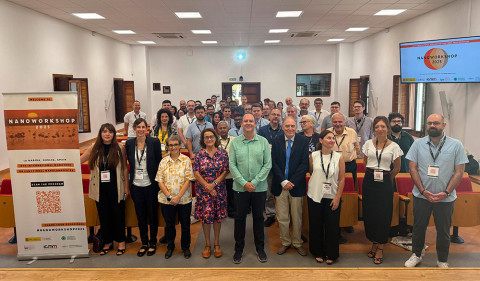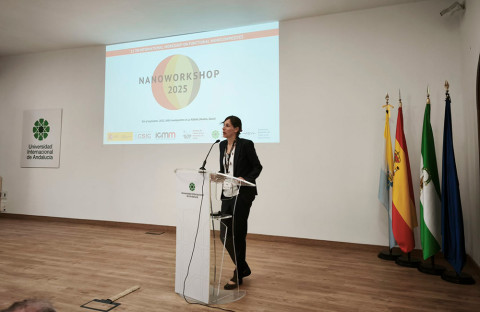The CSIC brings together more than 50 nanoscience experts at the UNIA to discuss the latest advances in the field

The Spanish National Research Council (CSIC), through the Materials Science Institutes of Seville and Madrid (ICMS and ICMM), brought together more than 50 researchers from over eleven countries this week to discuss the latest advances in nanoscience at the 12th International Workshop on Functional Nanocomposites, held at the Santa María de La Rábida campus of the International University of Andalusia (UNIA).
This international workshop, which is supported by the Spanish Association of Vacuum and its Applications (ASEVA), is a biannual event that brings together leading experts in advanced material preparation techniques and the study of their new properties, with a focus on the manufacture of new devices and industrial applications. It also includes theoretical simulations of these materials, as well as the use of AI for predictive behavior of both materials and equipment.
The conference was attended by Margarita Paneque, delegate of the Spanish National Research Council (CSIC) in Andalusia and Extremadura, and José Ignacio García, rector of the International University of Andalusia (UNIA). They opened the conference accompanied by Juan Pedro Espinós, director of the ICMS, and María de la O Barroso, director of the UNIA headquarters in La Rábida.
During the inauguration, the CSIC's highest representative in Andalusia emphasized that the CSIC supports these types of initiatives, "where people from different backgrounds and disciplines come together to achieve a common goal, which ultimately results in a product that can be transferred to companies."
For his part, García highlighted the UNIA's role in promoting quality research and the importance of these spaces for "discussing ongoing work, which represents scientific advances and developments, and which, through the sharing of these days, produce synergies, something important for the advancement of science and the acquisition of skills."

Nanoworkshop 2025 is being held in Spain for the first time since its launch in 2003 in Germany and its subsequent visits to Japan, the Czech Republic, Italy, Finland, India, and France. This year, the organizers were Lidia Martínez (CSIC-ICMM) and Ana Borrás (CSIC-ICMS), as well as Alexander Vahl of the University of Kiel (Germany).
The panel of invited speakers included Stefan Schröder, a researcher from the University of Kiel (Germany); Francesca Borghi, from the University of Milan (Italy); Daniil Nikitin, from Charles University in Prague (Czech Republic); Elvira Paz, from the International Iberian Nanotechnology Laboratory (Portugal); as well as Alberto Palmero, a researcher from ICMS-CSIC; and Pablo Ares, from the Institute of Condensed Matter Physics at the Autonomous University of Madrid.
The invited researchers were among the more than 50 members of the scientific community who, from last Monday to Wednesday, discussed and presented the latest results on new nanomaterial manufacturing techniques using green physics and chemistry technologies, as well as their applications for the production of new, more efficient and sensitive devices in the fields of energy, optics, sensors, and brain-inspired electronics, among others. Advanced characterization techniques such as near-field microscopy and new capabilities of the ALBA synchrotron were also presented.
Best Posters Awards
During the conference, in addition to the various oral presentations, the doctoral students attending the conference had the opportunity to present their ongoing research in a poster session held in the Newspaper Library at the UNIA headquarters. At this session, a six-member jury awarded three of the posters two prizes of €150 each and a second prize of €100.
The winners were Fernando Núñez Gálvez, a doctoral student at the University of Seville and member of the ICMS (National Institute of Statistics and Censuses) for his work "SLIPS-TENGs: Triboelectric Nanogenerators with Liquid-Infused Porous Surfaces as Highly Slippery Drop Energy Harvesters," and María Garrido from the Complutense University of Madrid for her poster entitled "Sputter-Deposited Gold–Iron Nanostructures for Magnetoplasmonic Applications." Furthermore, in this case the runner-up award went to Jaime del Moral, a CSIC doctoral student who is also completing his final year of his thesis at the ICMS and who defended his poster entitled Enhanced acoustic de-icing through thin film technology: exploring the link between acoustic waves and surface properties for energy-efficient ice protection.
Instituto de Ciencia de Materiales de Madrid (ICMM)
Sor Juana Ines de la Cruz, 3
Cantoblanco, 28049
Madrid, España
Telephone: (+34) 91 334 90 00
Email: @email
Communication Office: @email

Acknowledge the Severo Ochoa Centres of Excellence program through Grant CEX2024-001445-S/ financiado por MICIU/AEI / 10.13039/501100011033

Contacto | Accesibilidad | Aviso legal | Política de Cookies | Protección de datos